Play Behavior and its Impact on Animal Welfare
Author Names and Affiliations
- Dilruba Hasin
Associate Professor, Division of Veterinary Physiology, Faculty of Veterinary Sciences and Animal Husbandry, SKUAST- Kashmir, Shuhama, Alusteng, Srinagar-190006, Jammu and Kashmir, India (dhasin7@gmail.com)
- Aasif Ah Sheikh
Assistant Professor, Department of Veterinary Physiology and Biochemistry, College of Veterinary Sciences, GADVASU, Ludhiana, Punjab, India (aasifvet1@gmail.com)
- 3. Ovais Aarif
Assistant Professor, Division of Veterinary Physiology, Faculty of Veterinary Sciences and Animal Husbandry, SKUAST- Kashmir, Shuhama, Alusteng, Srinagar-190006, Jammu and Kashmir, India (ovaisaarif@gmail.com)
- Fozia Shah
Assistant Professor, Division of Veterinary Physiology, Faculty of Veterinary Sciences and Animal Husbandry, SKUAST- Kashmir, Shuhama, Alusteng, Srinagar-190006, Jammu and Kashmir, India (drfozia_vet@rediffmail.com)
- Mohd Rayees Dar
Associate Professor, Department of Veterinary Physiology and Biochemistry, Shriganganagar Veterinary College, Tantia University, Rajasthan, India (rayees21@gmail.com)
- Suhail Ahmad Khan
M.V.Sc. Scholar, Division of Veterinary Physiology, Faculty of Veterinary Sciences and Animal Husbandry, SKUAST- Kashmir, Shuhama, Alusteng, Srinagar-190006, Jammu and Kashmir, India (shuailkhann@gmail.com)
- KH Bulbul
Associate Professor, Division of Veterinary Parasitology, Faculty of Veterinary Sciences and Animal Husbandry, SKUAST- Kashmir, Shuhama, Alusteng, Srinagar-190006, Jammu and Kashmir, India (drkhbulbul@gmail.com)
- Zahoor A Pampori
Professor and Head, Division of Veterinary Physiology, Faculty of Veterinary Sciences and Animal Husbandry, SKUAST- Kashmir, Shuhama, Alusteng, Srinagar-190006, Jammu and Kashmir, India (dzap64@gmail.com)
Corresponding Author
Dr. KH Bulbul
Email: drkhbubul@gmail.com
Telephone: +91-9435480757
Play behavior and its impact on animal welfare
Dilruba Hasin, Aasif Ah Sheikh, Ovais Aarif, Fozia Shah, M Rayees Dar, Suhail Ah Khan, KH Bulbul and Zahoor A Pampori
Abstract
Behaviour is the expression of several physiological, endocrine, motor and emotional responses that are coordinated by the central nervous system from the processing of internal and external stimuli. Assessing the foundations of the neurobiology of animal behavior and animal wellbeing can help us better achieve about animal welfare. The mission of defining animal welfare indicators is methodologically difficult, limited and may be impossible. A promising alternative, however, to evaluate environmental conditions is the assessment of play behavior. Play behavior probably occurs in most vertebrates and some invertebrates, but predominantly in mammals. It is also more frequent in young males and is associated with the environmental context in which animals find themselves. Animals play if they are healthy and well-fed but they do not play if they are under stressful conditions or in a stressful state.
Keywords: Animal behaviour, neurobiological, physiological, endrocrine, response, play
Introduction
Behavior is the expression of several physiological, endocrine, motor and emotional responses that are coordinated by the central nervous system from the processing of internal and external stimuli. Most researchers agree that play behaviour is not easy to define, although it is easily identified. Play is characterized by countless patterns [1]. Each species has typical motor pattern which are displayed by the youngest animals quite uncoordinatedly, with exaggerated intensity and repetition compared to the adults. The mission of defining animal welfare indicators is methodologically difficult, limited and may be impossible. A promising alternative, however, to evaluate suitable environmental conditions is the assessment of play behaviour. Play behaviour is more readily identified in mammals, but it has evolved in many animal species, probably including invertebrates [2]. Play behavior exerts differentiated roles according to animal species [3], intra-specific characteristics, age and gender. Animals at different ages play differently and young individuals play more than adults. Some studies reported that play behaviour arises from intrauterine movements [4]. Play behavior is mainly performed by the youths, possibly because it provides short-term benefits to their development. Likewise, as animals get older play behaviour declines, possibly because the benefits are lost or the cost-benefit relation becomes disadvantageous. Animals at different ages play differently, and young individuals play more than adults. Some studies speculate that play behaviour arises from intrauterine movements [5], but neonatal mammals play less than youths do, and youths play more than adults, i.e. play behaviour is typical of youths [3]. In most animal species, males play more frequently than females. This relationship has been identified in baboons, chimpanzees, tamarins, dogs, coyotes, wolves, cats, rats, hamsters, gerbils and sheep [3]. Moreover, there is evidence that play is predominantly modulated by the sex of the play partner, where play increases in pairs of animals of the same sex [6]. In juveniles, play behaviour apparently promotes the ability to handle unexpected situations, versatility of emotional responses to recover from averse situations, and the development and training of physical and motor skills [7]. As a consequence, when these animals become adults they have optimised proficiency in dealing with situations that are relevant for survival, such as predatory behaviour, anti-predatory behaviour, coupling and social relationships [3]. Burghardt [2] defined play behaviour in a way that makes it more easily indentifiable in animals, which has contributed to studying this aspect in taxa other than mammals. Burghardt’s five criteria are (i) behaviour is not fully functional; (ii) play is spontaneous, voluntary, pleasurable, or autotelic; (iii) play differs from serious performance of ethotypic behaviour either structurally or temporally; (iv) behaviour is repeated but not stereotyped; and (v) behaviour occurs when the animal is in a relaxed state (e.g. well fed, safe, healthy).
Types of play behaviour
Play behaviour is categorized as social, object or locomotor play [2]. Social play involves two or more animals [7]. The individuals chosen as play partners are usually of similar age and size. Play fighting; a type of social play that has been observed in adult rats, i.e. social play behaviour persists at adulthood, albeit at lower frequency. Fight play is apparently aggressive and seems to have a competitive nature [8], but in contrast to an aggressive contest, animal injuries are not common during these interactions. Social play allows animals to develop social skills and facilitates their integration into groups. Object play involves activity devoted to an inanimate object and is related to the development of motor skills. Locomotor play involves jumping, running and performing other motor activities in a sudden, persistent and frenetic manner. It helps with training and physical development by promoting anatomical and physiological benefits such as development and strengthening of bones and muscles and by increasing cardiopulmonary capability. Locomotor play, which includes vigorous jumping, kicking, and running, often interrupted by fast stops and turns in a new direction, can be performed by several animals at the same time, but does not involve physical contact. In contrast with social play or play fighting which looks very similar in appearance to real fighting, locomotor play does not have to be separated from a “serious”, non-playful, counterpart.
Locomotor (Rotational) play
A kind of play in which an animal exhibits sustained or intense physical movements without clear reason. This behavior is usually solitary and can imply running, jumping or prancing. This category also includes movements in which the individual doesn’t move distances so much as move parts of their own body via rotational movements, such as shakes or twists of the body.
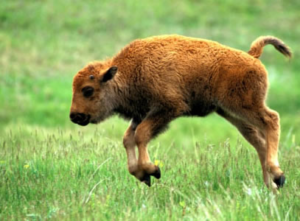 |
| Fig 1: Baby bison jumping (photo credit: Pinterest) |
Object play:
Object play is the involvement of inanimate objects of various kinds in an animal’s play activities. This behavior can either be solitary or social. Object play entails an animal interacting with an object. Much object play mimics predatory behavior, involving stalking or attacking motions. As one might expect, this type of play is particularly prevalent in predatory and scavenging animals. Fagen [9] defines ‘divertive interactions with an inanimate object including exploratory manipulation…when describing object play. It is a type of play behaviour familiar to pet cat and dog owners who regularly provide their pets with toys. In the absence of human manufactured toys…. domestic, captive and wild animals may use a wide variety of objects for example sticks, rocks, leaves, fruit, feathers, dead prey animals and even items of discarded human bric-a-brac as objects to play with. Object play is characterized by boisterousness and appears, anthropomorphically, to be enjoyable. Objects are thrown into the air, chased and captured, pulled to pieces, kicked, shaken and bitten of all ages play with objects.
While non-human primates and carnivorous species such as cats, dogs and bears, are regular performers, other animals also play with objects. Play with twigs, small stones and nutshells for example corvids, parrots and other birds is well known and play with human manufactured toys by a wide variety of zoo animals, from turtles to rhinoceroses.
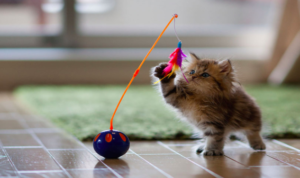 |
| Fig 2: Kitten playing with a toy (photo credit: Getty Images) |
Social play:
It involves the interaction of two animals with one another. Almost all social play occurs between con-specifics. One of the most common types of social play is play fighting, which mimics real fights, but lacks the level of aggression.
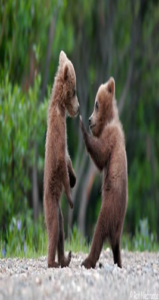 |
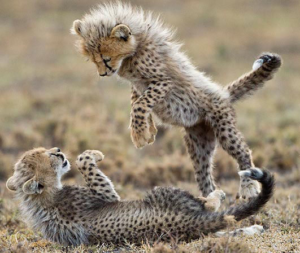 |
| Fig 3: Baby brown bears playing and cheetah cubs playing fighting (photo credit: Cate Barrow) | |
Neural mechanism that entails social play
Most of the research of neural mechanisms of play behavior has focused on the social play fighting of rodents, but some investigation has focused on brain regions associated with social play in primates. In rodents, the brain areas involved in play fighting tend to differ than those involved in adult fighting; however overlap has been observed in certain more aggressive types of play in some species. Phylogenetic primate research has found several regions associated with frequency of play, including the amygdala and hypothalamus. It is theorized that the hypothalamus is involved in the motivational and rewarding aspects of play while the amygdala contributes to social and emotional aspects of play. Research into the reward and motivational aspects of play in rats suggest that the endogenous opioid system mediates the hedonic aspects of social play while dopamine modulates the motivational properties of social play. Studies of rodent play fighting have found that the brain areas involved in play are different than those involved in adult aggression. Gordon et al [10] demonstrate this effect in rats by demonstrating differential c-Fos expression in juvenile rats after play fighting compared to adults in real fights. This trend, however, is not demonstrated in golden hamsters, where the line between juvenile play and adult fighting is blurred. These hamsters exhibit two different types of play fighting where one style of playing is less playful than the other and sets up hierarchical social structures. Cheng et al [11] 2008 demonstrate that the more aggressive type of playing activates many brain regions involved in adult fights. Less experimental data has been collected focusing on the neural mechanisms involved in primate social play, but some correlational evidence has pointed to the neo-cortex, cerebellum, amygdala, and hypothalamus as primary areas involved in social play.
The larger relative sizes of these regions in primates are correlated with increased play frequency. The amygdala is hypothesized to be involved in the social and emotional aspects of play due to its relevance in emotional recognition outside of play. Additionally, phylogenetic comparative analysis has suggested that the amygdala’s role in social play reflects the same regulation of the expression of aggression and submission in adult aggression. The hypothalamus’s role in play is theorized to reflect motivational aspects in play due to its role in the regulation of motivation of several behaviors.
 |
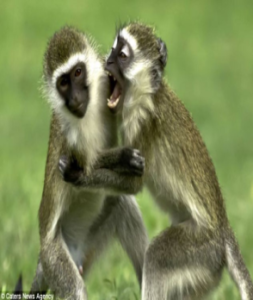 |
| Fig 4: Social playing and Vervet monkeys playing fighting (photo credit: Getty Images) | |
Reward and motivational aspects of play
The most successful and prevalent research on the motivational and hedonic mechanisms of social play have focused on neurotransmitters involved in rat play fighting. The endogenous opioid system mediates the hedonic aspects of social play while dopamine modulates the motivational properties of social play. Evidence that opioids are involved in play comes from the fact that treatment of opioid agonists enhances social play while antagonists reduce social play. This system is said to involve hedonic properties rather than motivational ones as opioid agonist treatment in a paradigm where rats had to work for social play increased frequency of play without improving performance. This system is said to involve hedonic properties rather than motivational ones as opioid agonist treatment in a paradigm where rats had to work for social play increased frequency of play without improving performance. The effect of dopamine is more complicated. Treatment of dopamine antagonists reduce social play, while dopamine receptor agonists have been demonstrated to produce both increases and decreases in playing behavior, however, the reported increases have been very small. The lack of effect of dopamine agonists likely reflects optimal dopamine signaling during play, where further stimulation of this signal no longer enhances social play.
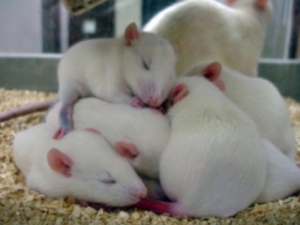 |
| Fig 5: Pyramid of sleeping rat pups (Credit: Photo: Andrea Gore) |
Modulation of social play
The modulation of play fighting has also been primarily studied in rats. Rats are a useful species to study because they modulate their defensive tactics during play fighting according to age and partner; young male rats tend to use a complete rotation tactic while older males switch to a partial rotation tactic and subordinate males engage in the complete rotational tactics while dominant males use the complete rotational tactic (females generally always use the complete rotational tactic). The brain regions found to be important to the modulation of play fighting include the prefrontal cortex, the motor cortex, and the striatum. Kamitakahara et al [12] demonstrate that the prefrontal cortex is necessary for partner related modulation, while the motor cortex is necessary for age related modulation of defensive techniques in a series of ablation studies. These areas appear to be involved solely in the modulation of play fighting, as these ablations did not affect the rat’s ability to perform defensive tactics, nor did it affect frequency of play fighting. The striatum, part of the forebrain involved in reward, may also play a role in the modulation of play fighting. Lesions here prevented rats from making normal transitions between play behaviors without affecting the ability to produce these behaviors.
Cost and utility of play behaviour
Play behavior are generally related to the development of strength, motor coordination and physical resistance; learning of novel environmental information and acquisition of social skills, all of which enhance flexibility and versatility of animal actions so that they are prepared to handle future real-life situations. For instance, learning from experiences in different social contexts improves intra- and inter-specific competition strategies and facilitates group cohesion. With respect to physical development, responses to novel situations become faster (fine-tuning), thereby providing adaptive and competitive advantages. Fine-tuning may prepare individuals for exploring the environment and increase their ability to tolerate different environments [13]. The capacity of rapid response to environmental changes might improve cognitive development, the processing of new information and creativity. The benefits of play behavior are not completely understood, although the suggested hypotheses are conceivable. In some cases, the role of play behaviour is not evident or is even absent, and this action could indeed be performed at great cost to animals. In this case, play might be a side product of other beneficial processes that counteract the costs of play.
Thus, play parse need not, at least early in its evolution, have more benefits than costs. The energetic cost of play behavior is insignificant if feeding is adequate [14] or if it favours the development of other skills, as is the case for the predatory activity of cheetahs [15]. Thus, the energetic expenditure with play behaviour does not compromise fitness. Barber [16] stated that benefits conferred by play behaviour, such as increased resistance against pathogens, outweigh its costs.
Impact on animal welfare
Play behavior as a new and promising potential indicator of animal welfare. There are evident of emotions associated with play – joy and happiness – that drive animals into it. Play in rodents is regulated by neurotransmitters that are known to play roles in other pleasurable activities. Animals play only if they are healthy, safe, well-fed and in a relaxed state, but not if they are under a stressful condition. Therefore, play behavior can be used as an indicator of animal welfare. Newberry et al. reported that piglets reared under intensive housing conditions may be unable to express their full repertoire of playful behavior due to limitations of space. Many animal species probably display play behaviour, such as octopus [17], reptiles [18] and birds [1], but play is primarily observed in mammals, possibly because they have a long immaturity period, are dependent on parental care and have high encephalisation [19]. Animals at different ages play differently, and young individuals play more than adults. Some studies speculate that play behaviour arises from intrauterine movements, but neonatal mammals play less than youths do, and youths play more than adults, i.e. play behaviour is typical of youths [[3].Accordingly, the main period the animal plays coincides with the main period of physical, hormonal and social development, which suggests that play behaviour can indeed modulate developmental aspects [9]. Therefore, play behaviour is mainly performed by the youths, possibly because it provides short-term benefits to their development. Likewise, as animals get older play behaviour declines, possibly because the benefits are lost or the cost-benefit relation becomes disadvantageous. The end of parental care and the redirection of animal efforts towards survival, growth and reproduction account for the decreased time and frequency of play behaviour in adulthood. In most animal species, males play more frequently than females do [20] (Vieira et al., 2005). This relationship has been identified in baboons, chimpanzees, tamarins, dogs, coyotes, wolves, cats, rats, hamsters, gerbils and sheep [3]. Moreover, there is evidence that play is predominantly modulated by the sex of the play partner, where play increases in pairs of animals of the same sex. Environmental conditions, for example resource availability and social conditions modulate play behavior [19]. For instance, zoo chimpanzees have decreased aggressiveness and competition for food before feeding if they perform play behaviour and grooming [21].
Conclusion
Detrimental environmental conditions stop the playfulness in most of the animals but under favourable conditions through its rewarding, self-reinforcing properties, become prominent in the behavioural repertoire of infants and juveniles. The two self-reinforcing properties of play i.e. first, play probably provides the animal with psychological benefits in the form of an opioid-mediated pleasurable experience, and animals that feel well will play more; second, play has a tendency to spread to other individuals, which may result in a contagious build-up of play in groups. These properties lead us to conclude that play should be investigated not only as a potential welfare indicator but also as an agent for improving the current and future welfare of an individual or a group. There may be future research into the relationship between animal play and welfare may expose two broad forms. The first will define, describe and quantitatively analyse the species-specific play behaviour of the most important captive, domestic animals and will investigate play as a welfare indicator and as a tool to improve welfare in the different species. Second, applied ethology and animal welfare science will work in tandem with other behavioural, neuro-physiological, psychological, evolutionary and philosophical disciplines towards a deeper fundamental understanding of play as a unique behavioural phenomenon.
References
- Gamble JR, Cristol DA. Drop-catch behaviour is play in herring gulls, Larusargentatus. Animal Behavior. 2002; 63: 339-345.
- Burghardt GM. In: Greenberg A, Haraway M (eds) Comparative psychology: a handbook. Garland, New York, 1999; pp: 725-735.
- Vieira ML, Sartorio R. Motivational, causal and functionalanalysis of play behavior in two rodent species. Estudios Psicologia. 2002; 7:189-196.
- Hamburger V. Some aspects of the embryology of behavior. Quarterly Review Biology. 1963; 38:342-365.
- Bekoff M. Social play behavior. Bioscience. 1984; 34:228-233.
- Guerra RF, Vieira ML, Takase E, Gasparetto S. Sex differences in the play fighting activity in golden hamster infants. Physiology and Behaviour. 1992; 52:1-5.
- Spinka M, Newberry RC, Bakeoff M. Mammalian play: training for the unexpected. Quarterly Review Biology. 2001; 76:141-168.
- Pellis SM, Field EF, Smith LK, Pellis VC. Multiple differences in the play fighting of male and female rats. Implications for the causes and functions of play. Neuroscience Biobehavior Review. 1997; 21:105-120.
- Fagen R. Animal play behavior. Oxford University Press, New York. 1981.
- Gordon NS, Kollack-Walker S, Akil H, Panksepp J. Expression of c-fos gene activation during rough and tumble play in juvenile rats. Brain Research Bulletin. 2002; 57(5):651-9.
- Cheng SY, Taravosh-Lahn K, Delville Y. Neural circuitry of play fighting in golden hamsters. Neuroscience. 2008; 156:247-256.
- Kamitakahara H, Monfils MH, Forgie ML, Kolb B, Pellis SM. The modulation of play fighting in rats: Role of the motor cortex. Behaviour Neuroscience. 2007;121:164-176.
- Geist V. Life strategies, human evolution, environmental design: toward a biological theory of health. Springer Verlag, New York. 1978.
- Siviy SM, Atrens DM. The energetic costs of rough-and tumble play in the juvenile rat. Developmental Psychobiology. 1992; 25:137-148.
- Caro TM. Short-term costs and correlates of play in cheetahs. Animal Behaviour. 1995; 49:333-345.
- Barber N. Play and energy regulation in mammals. Quarterly Review Biology. 1991; 66:129-147.
- Kuba MJ, Byrne RA, Meisel DV, Mather JA. When do octopuses play? Effects of repeated testing, object type, age, and food deprivation on object play in Octopus vulgaris. Journal of Comparative Psychology. 2006; 120:184-190.
- Burghardt GM, Ward B, Rosscoe R. Problem of reptile play: environmental enrichment and play behavior in a captive Nile soft-shelled turtle, Trionyx triunguis. Zoo Biology. 1996; 15:223-238.
- Bekoff M. 1988. Motor training and physical fitness: possible short and long-term influences on the development of individual differences in behaviour. Developmental Psychobiology. 1988; 21:601-612.
- Vieira ML, Garcia MP, Rau BDW, Prado AB. Effects of different opportunities for social interaction on the play fighting behavior in male and female golden hamsters (Mesocricetusauratus). Developmental Psychobiology. 2005; 47:345-353.
- Palagi E, Cordoni G, Tarli BSM. Immediate and delayed benefits of play behaviour: new evidence from chimpanzees (Pan troglodytes). Ethology. 2004; 110:949-962.


